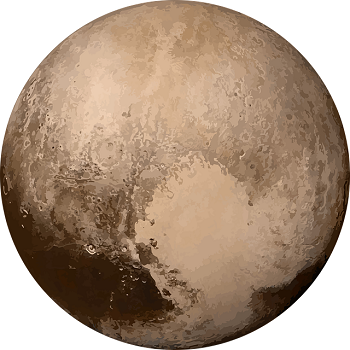Most people have several doubts on why Pluto is not a planet anymore. The most asked among them are
1. Is Pluto Destroyed?
2. Is Pluto Deviated from its path?
3. Is Pluto not orbiting the Sun?
All these doubts and presumptions on why Pluto is not a planet anymore will be explained in this article in a simple and lucid manner.
So, why Pluto is not a planet anymore?
Short answer: Pluto is not a planet anymore because it doesn’t fit into the new definition of Planets.
There are many objects in space which move around in our Solar system. These objects are precisely called as celestial objects. These celestial objects may or may not orbit our Sun. These objects may be big or small. They may have different composition and structure.
Based on their size, structure (shape), orbit (the path they travel), composition (what they are made up of), they are classified either as a Planet, Star, Dwarf Planet, Satellite, Comet or an Asteroid.
Difference between Asteroid, Meteor, Meteorite, Meteoroid and Comet
The designation of celestial object as a planet, comet or satellite is given by the International Astronomical Union (IAU). The International Astronomical Union consists of professional astronomers at International level who are responsible for classifying whether a celestial object is a planet or satellite or any other object.

Every three years, IAU takes up new resolutions at their General Assembly. The resolutions are passed by the majority of votes during the General Assembly.

At Such General Assembly conducted in 2006, Pluto lost its Planetary Status when IAU redefined the definition of a Planet.
What is the need for new definitions?
Since the discovery of Pluto in 1930, Pluto has always been in debate. The reasons for this debate are
Size
Pluto is the smallest planet in our solar system. Infact it is smaller than the Earth’s Moon.

Composition
All the inner planets namely Mercury, Venus, Earth and Mars which are not beyond the Asteroid belt are called Terrestrial Planets. They are called so due to their composition. All terrestrial planets have dense and rocky surface. While the outer planets which are beyond the Asteroid Belt are called Jovian Planets or Gaseous Planets because most of their surface is composed of gases such as hydrogen, helium and traces of methane. Jupiter, Saturn, Uranus, and Neptune are called as Jovian Planets.
In this Scenario, the next planet which comes after Neptune must be gaseous planet just like the other Jovian planets which are beyond the Asteroid belt. But Pluto in contrary is a terrestrial planet whose surface is dense and rocky.
Other Factors
Erratic Orbit of Pluto, Binary System of Pluto and Charon (its largest moon), and resemblance to Neptune are some factors which are debatable. Some scientists even think Pluto was once a moon of Neptune.
Mysteries of Pluto – Discovery, Classification, Debate & Facts
Near End to this Debate
This debate on planetary status of Pluto nearly came to an end on July 29, 2005 when group of Astronomers at The California Institute of Technology (Caltech) discovered a new trans-Neptunian object Eris which was found to be more massive than Pluto. This hinted the introduction of Eris as the Tenth planet into our Solar System. Astronomical community had to start a fresh debate on the status of these minor planets. Finally, there was a need for New Definition of Planet.

Final End
The long running debate finally came to an end on Aug 24th, 2006 when 2500 Astronomers at the 26th General Assembly for the International Astronomical Union passed two important resolutions by voting. They are
Resolution 5A: “Definition of ‘planet’ ”
Resolution 6A: “Definition of Pluto-class objects”
According to this new resolution 5A, there are three conditions for a celestial object in the Solar System to be considered a planet:
1. The celestial object must orbit the sun.
2. The celestial object must be (nearly round) shape. (It must assume hydrostatic equilibrium)
3. The celestial object must have cleared the neighbourhood around its orbit.
The first two conditions were fulfilled by Pluto since it orbits the Sun every 248years and it is massive enough to be near round.
But it failed to meet the requirement of third condition.
Astronomical observations of Pluto suggest that Pluto has not cleared its neighbourhood, which means there are still many objects which are not influenced by the gravity of Pluto and hence they do not fall into Pluto. For a celestial object to be a planet, it must have strong gravity to clear their neighbourhood.
If Pluto is not a planet anymore, then what is Pluto?
Now here comes the Resolution 6A which defines Pluto and objects similar to Pluto. According to this Resolution 6A, Pluto is called as a Dwarf Planet.
Therefore Pluto is not a planet anymore but Pluto is a Dwarf Planet.
Definition of Dwarf Planet
Resolution 5B defines the requirements of Dwarf Planets.
1. The celestial object must orbit the sun.
2. The celestial object must be (nearly round) shape. (It must assume hydrostatic equilibrium)
3. The celestial object must have cleared the neighbourhood around its orbit.
4. The celestial object must not be a Satellite.
Since Pluto falls under this category, Pluto is a Dwarf Planet.
All Resolutions are listed in the official website of The International Astronomical Union.
Watch the Video in Telugu
Our Solar System – Planets, Dwarf Planets, Asteroid Belt & Kuiper Belt
Topic Quiz
Take the Complete Topic Quiz and test your Knowledge
1. Which international authority is responsible for the designating celestial bodies?
(a) International Council for Science (ICSU)
(b) Working Group on Star Names (WGSN)
(c) The International Astronomical Union (IAU)
(d) The Royal Astronomical Society
Answer: (c)
Get stories like this one in your inbox: Sign up for our email and Subscribe Now To Get The Most Anticipated Edition Of Starry Stories Magazine For Free.
Popular Starry Stories Posts
50 Interesting Space Questions Answered
Rosy Starlings – The Birds that Teach us Communal Harmony
Keywords
Why Pluto is not a planet
References
https://en.wikipedia.org/wiki/Pluto
https://www.popsci.com/why-is-pluto-no-longer-planet#page-2
https://science.howstuffworks.com/pluto-planet.htm
Photos, Vector Graphics & Illustrations Credits
Pixabay: 1 million+ Stunning Free Images to Use Anywhere
Pngtree: Millions of PNG Images, Backgrounds and Vectors for Free …


I really appreciate this post. I have been looking all over for this! Thank goodness I found it on Bing. You have made my day! Thx again!